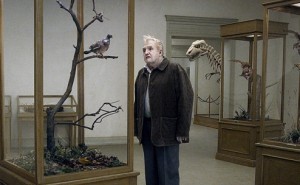 Sometimes I feel compelled to describe a movie as “difficult,” and it seems almost like I’m about to apologize for it. As if a film has to justify itself for not being as clear and simple as, say, an Errol Flynn adventure. Well, I happen to believe that artistic expression needs to make room for the strange and obscure. I don’t think I should have to choose between Charles Dickens and Samuel Beckett. I would like to have both, please. Beckett in particular comes to mind when considering the latest provocation from Swedish writer-director Roy Andersson, a film with the faintly ridiculous title of A Pigeon Sat on a Branch Reflecting on Existence.
Sometimes I feel compelled to describe a movie as “difficult,” and it seems almost like I’m about to apologize for it. As if a film has to justify itself for not being as clear and simple as, say, an Errol Flynn adventure. Well, I happen to believe that artistic expression needs to make room for the strange and obscure. I don’t think I should have to choose between Charles Dickens and Samuel Beckett. I would like to have both, please. Beckett in particular comes to mind when considering the latest provocation from Swedish writer-director Roy Andersson, a film with the faintly ridiculous title of A Pigeon Sat on a Branch Reflecting on Existence.
The film is a series of discrete scenes, composed in long takes with a stationary camera, for the most part with interior and somewhat artificial looking sets illuminated by sharp color photography. The people in the scenes are generally still—more still than people would be in real life—what movement and dialogue there is tends to be quite slow and deliberate. For example, an old woman holds on to a suitcase on her deathbed. She wants to take her money and jewels with her to heaven. She cries when her adult children try to take it from her hands. Another example: A man waiting at a bus stop. He overhears that it’s Wednesday, which surprises him because he thought it was Thursday. Another person carefully explains to him that Wednesday must logically occur before Thursday. What’s the overall effect of these eerie, meticulously composed scenes? It’s as if all society was draped in depression, a depression so pervasive that no one realizes it’s there.
As it turns out, there are recurring characters—primarily two glum and incompetent salesmen peddling the most pathetic novelty items you could imagine—vampire teeth, a bag that laughs when you squeeze it, and an ugly rubber mask that they call Uncle One Tooth. “We want to help people have fun,” they say, a statement that is darkly humorous coming from these two unhappy people. Another phrase that keeps popping up, said by many different people throughout the film, is “I’m glad to hear you’re doing so well.” Forget the banality of evil; this is the banality of normal.
There are in fact quite a few very funny aspects to the film, but if you’re looking for Monty Python you’ll be disappointed. Andersson’s humor is the “laugh to keep from crying” variety, which doesn’t prevent some characters from crying anyay. There’s even a bit of defiant joy in a flashback by an old man to a scene in a barroom in the 40s where a singing waitress takes kisses from soldiers as payment for drinks, all to the tune of “The Battle Hymn of the Republic.” Time itself is not reliable, as we see in a scene set in a diner, with a jukebox playing rockabilly music, when the army of the 17th century Swedish king Charles the Twelfth suddenly enters on horseback, ordering everyone around. Later, when the army is retreating from its terrible defeat by the Russians, the king returns to the diner for a much needed bathroom break.
The meaning of the title is hinted at in a scene where a child tries to explain a poem to a school assembly. The overall meaning of the film only registers viscerally, through total immersion in Andersson’s bitterly ironic world view. That his opinion of society is not arbitrary, but has a political significance, becomes clear in a scene near the end which I won’t describe, except to say that it encapsulates modern history with a grotesque and horrifying precision. A Pigeon Sat on a Branch Reflecting on Existence: it’s strong stuff—pity and terror, gallows humor, conveyed through the most absurd and unassuming gestures.

